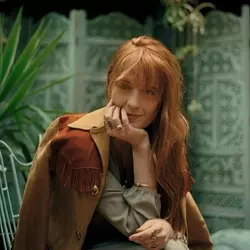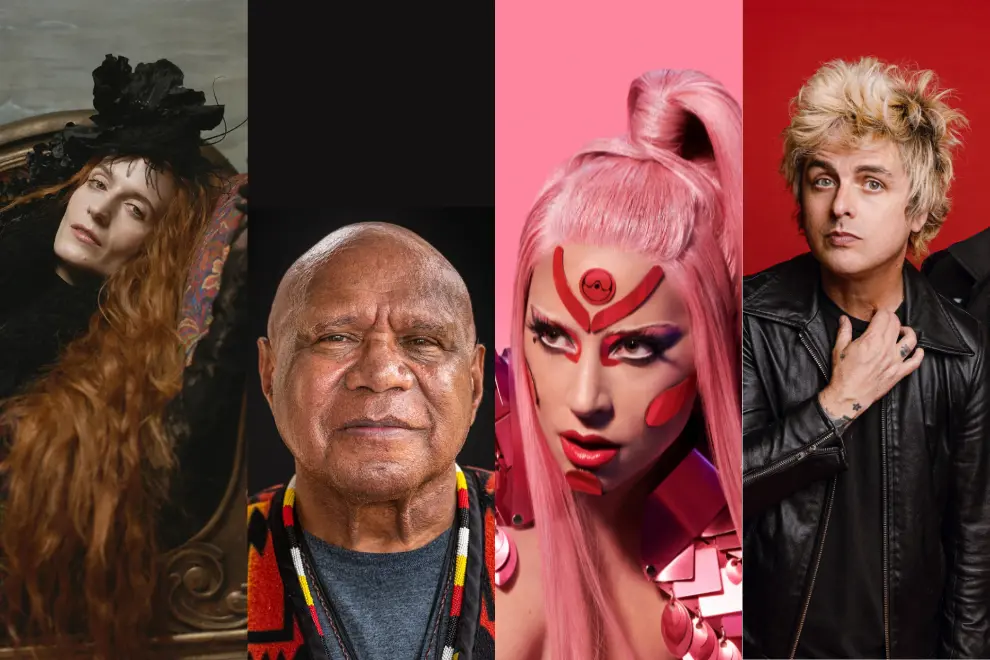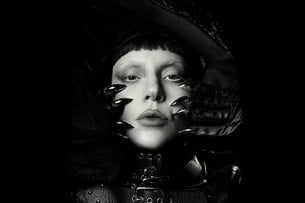 Florence & The Machine
Florence & The MachinePainters get inspired by music as they paint. In Australia, Brett Whiteley, Nell and Abdul Vass had a penchant for AC/DC. Sidney Nolan and Margaret Olley listened to classical music on the radio.
With so many musicians coming out of art school, it’s not surprising that hundreds of rock songs were inspired by paintings and painters. Here are 15 of them.
Florence + The Machine – Dog Days Are Over
Florence Welch’s daily bicycle commute to Central London took her over Waterloo Bridge. For six months there was a poster by Swiss artist Ugo Rondinone outside Hayward Gallery, with DOG DAYS ARE OVER in large, rainbow-coloured letters. Welch told MOJO: "It's a reference to the dog star, Sirius. When it was closest to the Earth, all the animals would get languid and sleepy. When it moved away, they'd wake up.”
Archie Roach – Native Born
Native Born was a tribute by Archie Roach to Albert Namatjira, the Arrernte man from the MacDonnell Ranges in the Northern Territory, whose works he grew up mesmerised by. “His paintings weren’t just about the landscapes,” Roach said, “but you felt something spiritual in them, the spirit of his country. We have to realise that everyone in Australia walks on spiritual land.”
Don McLean – Vincent
The global hit (reaching #3 in Australia) is wrongly referred to because of the opening line, “Starry, starry night,” a reference to Dutch post-impressionist Vincent Van Gogh's June 1889 painting The Starry Night. It depicted the view outside of Gogh’s room in the mental asylum at Saint-Rémy-de-Provence (where he went following a nervous breakdown, during which he cut off his left ear after apparently being rejected by a woman). The song’s lyrics compare the blue and dark tones of the painting in contrast with the golden shine of the stars in the background.
In 1970, American singer songwriter Don McLean came across a book on Van Gogh while singing at a school. It was a far cry from the accepted story of a crazy man who shot himself at 37 on July 27, 1890. “Suddenly I knew I had to write a song arguing that he wasn't crazy,” he recalled. “So I sat down with a print of Starry Night and wrote the lyrics out on a paper bag." Those handwritten lyrics, on sale for $1.5 million in 2020, included the lines: “You took your life, as lovers often do, but I could’ve told you Vincent, this world was never meant for one as beautiful as you.”
It was one of poet/rapper Tupac Shakur’s favourite songs, and played to him on the night he was rushed to a Las Vegas hospital after being shot in a drive-by.
Spoon – The Beast And Dragon, Adored
The Beast And Dragon, Adored was the original title for Spoon’s 2005 album Gimme Fiction. It was the last song they recorded for it, so the idea was to mention as many of record’s song titles in that song. The title came from 16th century French paintings singer Britt Daniel found in a book of tapestries. “They were signs of the apocalypse, and I had grown up hearing a lot about the apocalypse,” said the lapsed Catholic.
David Bowie – Andy Warhol
Written about his early hero, David Bowie went to the Andy Warhol's New York studio The Factory in September 1971 to play it in person. The artist hated it. After the performance was an awkward silence. He finally spoke. He said to Bowie, “I like your shoes.”
Lady Gaga – Venus
From 2013’s Artpop, it references Sandro Botticelli's painting The Birth Of Venus and was apparently inspired by Lady Gaga’s desire to dance whenever she heard the Roman goddess of love’s name being mentioned.
According to the Gagster, “it’s also about the planets. So, this song is about faith, but it’s also about finding faith in other places – in the beyond – and, my experience with love being something that took me a really long time to find.’’
She expanded: “This song’s really about sex, but it’s about sex in the most mythological way.”
Green Day – Boulevard Of Broken Dreams
By the time it came to making American Idiot, success had seriously messed up Green Day’s collective minds. Just before recording began in earnest, frontman Billie Joe Armstrong split to New York for a few weeks, walking around the streets at night by himself. As he sang, “I walk a lonely road, the only one that I have ever known…”
During a 2005 episode of VH1 series Storytellers, he told the audience that the name came from “an old James Dean photo where he’s walking in New York, and it was called Boulevard Of Broken Dreams.”
Armstrong was wrong. The iconic windswept photo of the ‘50s actor and rebel was shot by Dennis Stock in 1955, titled James Dean Alone In The Rain, In The Middle Of Times Square, as a study of isolation. But the name Boulevard Of Broken Dreams was in fact on a painting by Gottfried Helnwein featuring Dean, Elvis Presley, Marilyn Monroe and Humphrey Bogart hanging out in a bar.
Klaxons – Echoes
Echoes, from Klaxons' Surfing The Void album, has the line, "Numberless names within the force of the ninth wave." It is a reference to The Ninth Wave, an 1850 painting by Russian-Armenian artist Ivan Aivazovsky which shows sailors clinging to the broken mast of a wrecked ship following a violent storm. “The ninth wave” was an ancient sailor expression about a series of progressively high waves, with the ninth being the destructive one. The cross-shaped mast and the bright light in the sky suggested a Christian allegory for redemption and salvation.
Robert Forster – The River People
When living in Sydney, former Go-Betweens member Robert Forster spent a lot of time at the NSW Arts Gallery, which was close to his house. One piece he continually went back to was by Australian artist Rupert Bunny, called Tritons. It was a grey and blue piece, of people in the water “whom I thought to be free spirits” turning to look at the artist, and “one man looking directly at the viewer, [with] long hair and a beard, [with his] hands up in the air.”
The image could well have come from a 1960s hippie festival. But it was actually painted around 1890. “The images in this painting spoke to me,” Forster said. He did something he’d never done before: he brought a notebook to the museum, sat in the front of the painting and wrote down his impressions of what was coming to him. The result was The River People, off his debut solo album Danger In The Past.
Tori Amos – 16 Shades Of Blue
When Tori Amos turned 50, she spoke to a number of women from different generations on what the passing of time meant to them. Faced with such different viewpoints, 16 Shades Of Blue was inspired by French post-impressionist painter Paul Cezanne, for whom the lifelong art lover discovered 12 months earlier. He’d use 16 shades of blue on his palette.
Against Me! – 333
In 2015, when Florida punk band Against Me! were in Bilbao, Spain for a European tour, they had some hours to kill before soundcheck so they visited the Guggenheim art museum. Frontwoman Laura Jane Grace wrote the song immediately at soundcheck, the lyrics mentioning the pieces on show as One Hundred And Fifty Multicolored Marilyns, The Renowned Orders Of The Night and Tarot Garden.
Grace explained the song, which appeared on the band’s Shape Shift With Me album: “I’ve never been as moved by an art museum experience before. I can’t even begin to explain how profound it was to me. In that moment, I really just felt how truly lucky I was to be there in Spain, on tour with my band, travelling, playing music, having adventures – living.”
Nat “King” Cole – Mona Lisa
One of the best known pop songs about a painting, Mona Lisa ponders the mysterious smile by the woman in the Leonardo da Vinci painting. Is it to cover up a heart broken or tempting a lover? The song was written by Ray Evans and Jay Livingston for the 1949 Paramount Pictures film Captain Carey, U.S.A. It started life as Evans noticed a resemblance to the woman to his own wife.
Delivered by the silky tones of American jazz-pop crooner and pianist Nat “King” Cole, the song held the #1 spot on the US charts for eight weeks, and won the Oscar for Best Original Song in 1950. Initially it was the B-side to Cole’s The Greatest Inventor Of Them All, but radio flipped it. Then in 1986, the song was used as the theme song for the British film Mona Lisa starring Bob Hoskins, Cathy Tyson and Michael Caine, and Cole’s version was inducted into the Grammy Hall of Fame in 1992.
Coldplay – Viva La Vida
Viva La Vida is Spanish for “the life lives”, and was inspired by a painting of that name by Mexican artist Frida Kahlo. It was one of the last paintings she did before her death in 1954, and frontman Chris Martin was more inspired by her strength. She painted it suffering from a broken spine, polio and years of chronic pain. “I just loved the boldness of it," Martin said.
Leonard Cohen – Ballad Of The Absent Mare
Leonard Cohen returned from a Buddhist silent retreat inspired by the 12th century work Mare Ten Bulls (or Ten Ox-herding Pictures), a series of short poems and Japanese woodcuts intended to illustrate the stages of a Mahayana Buddhist practitioner's progression towards enlightenment. The song was recorded by Jennifer Warnes and Emmylou Harris.
Jesca Hoop – Ode To Banksy
American singer songwriter and guitarist Jessica "Jesca" Ada Hoop wanted as much to convey her admiration for Banksy’s work as her dismay that he was losing the mystery of his identity. “While I was writing the song there were big press blasts to reveal his identity... which I ignored,” she said. “I'll keep him masked, thank you!”








